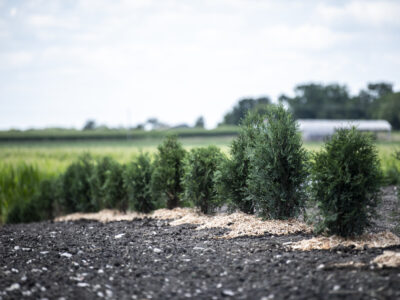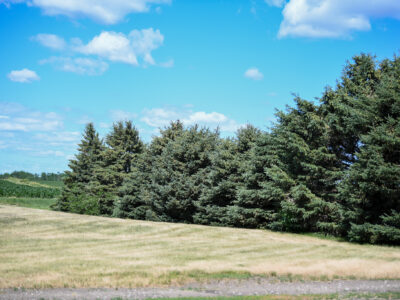In areas of high winds and blowing snow, windbreaks serve the dual purposes of modifying climatic factors and providing methods for managing snow. In open areas, wind lifts, carries, and deposits snowflakes… By modifying wind flow, blowing snow can be distributed over a field or deposited within a given area.
Living Snow Fences
In those situations where the goal of snow management is to confine the snow to a limited area, a dense windbreak of trees and shrubs can be a cost-effective method of controlling blowing snow… Living snow fences have greater snow storage capacity (than slat-fence barriers), require less maintenance once they are established, have a longer life span, and provide multiple benefits such as livestock protection, crop protection, soil erosion control, wildlife habitat, and aesthetic value.
Design and Location
In major storms, short (3-4 feet), vertical slat fences reach their snow-storing capacity quickly. Wind-driven snow then sweeps across the saturated barrier causing drifting in the roadway and reducing visibility. In open, windy areas blowing snow often continues long after the actual snowfall has stopped. If the snow fence is already full, snow drifts may continue to develop and repeated drift removal may be necessary. In contrast, a three-row living snow fence (20 feet tall) will store the same amount of snow but at a fraction of the cost.
A living snow fence achieves optimum snow storage capacity when winter density of the individual rows is about 50 – 60%. As density increases, drifts become deeper and shorter. Windbreaks with very close spacing, both within the row and between the rows (densities greater than 60%) may be damaged by deep, heavy snow drifts. Remember that density will vary with the number and spacing of the tree rows, the species chosen and the distance between trees within the row. The height of the trees is also important since snow storage capacity increases more than four times when the height doubles. For example, a three-row, mature, living snow fence with a height of 20 feet will store over 16 times more snow than a single–row slat-fence (height = 3 to 4 feet).
Species will vary depending on climate, soil, and available space and should be chosen based on local growing conditions and the objectives of the landowner.
Snow Control for Farmsteads and Feedlots
The main objectives of farmstead or feedlot windbreaks are to reduce the force of the winter wind on the activities within the sheltered zone and to enhance the microclimate on the leeward side of the windbreak. An additional benefit of these windbreaks can be the management of blowing and drifting snow.
With no windbreak protection, farm houses and other buildings act as solid barriers to the wind, resulting in swirling wind currents around corners or structures. Driveways and work areas may be subject to snow drifting, become inaccessible, and require additional hours of labor to remove the snow. A properly designed windbreak can catch and store most of the snow, reducing the need for snow removal.
One purpose of feedlot and livestock windbreaks is to maintain an area relatively free from deep snow where hay and other feed are stored. These windbreaks provide a haven where livestock can get out of strong winds and driving snow. This reduces animal stress and decreases feeding requirements, resulting in better animal health, lower death losses, and lower feed costs.
Design and Location
Farmstead or feedlot windbreaks should be designed with enough room to allow for a leeward snow drift. The ends of the windbreak should extend beyond the farmstead or feedlot to prevent the drift which forms at the end of a windbreak from interfering with farm operations.
For any windbreak designed to capture snow in high use areas, allowance must be made for controlling the runoff from melting snow. Property drainage is critical since excess water from melting snow will result in muddy conditions which are inconvenient to the landowner and cause serious problems for livestock in feedlot operations. In the case of feedlot windbreaks, runoff from the feedlot also must be controlled and not allowed to damage the windbreak.
One method controlling snow when space is limited is to establish a single or double row of dense shrubs located parallel to the main windbreak and 50 to 100 feet to the windward side. This will provide a trip row for blowing snow, reduce the size of the snow drift in the main windbreak, and reduce potential damage to the main windbreak caused by heavy snow loads. The area between the shrub row and main windbreak can be cropped and may be an ideal site for wind sensitive crops such as vegetables. Again, be sure to provide for the runoff from melting snow.
Typical windbreaks for snow control around farms, ranches, or feedlots consist of four to six rows (row of shrubs, two or three rows of conifers and one or two rows of tall deciduous trees). In northerly areas additional rows may need to be incorporated in order to provide adequate protection from cold winds and heavy snow. The specific designs for these types of windbreaks must be developed for individual locations and circumstances.



